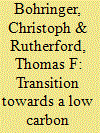| Srl | Item |
| 1 |
ID:
125878


|
|
|
|
|
| Publication |
2013.
|
| Summary/Abstract |
The sharp increase in global food prices during 2007-2008 has triggered the awareness of food insecurity problems and their impacts on the low-income, food-deficient countries, many of which are located in East Asia. Protein and fat consumption are higher in East Asia than that of other regions, although the percentage of carbohydrates consumed is slightly lower than the world's average. Nevertheless, the food security situation in East Asia was good relative to other countries in the world. The food security in East Asia is largely contributed by domestic production. Despite of a doubled import of foods over the last decade to meet its ever-growing population, Asia remains the least dependent among all regions on food imports. However, the raised energy costs and grain prices due to increasing grain demand for biofuel purposes appeared to exacerbate the undernourishment of poor households in the region. While most of the government interventions focus on short-term measures such as reducing domestic food prices through trade or price control, the risk of facing a long-term food insecurity still exists, which may render national action inadequate and require multilateral cooperation.
|
|
|
|
|
|
|
|
|
|
|
|
|
|
|
|
| 2 |
ID:
119781


|
|
|
|
|
| Publication |
2013.
|
| Summary/Abstract |
In the transition to sustainable economic structures the European Union assumes a leading role with its climate and energy package which sets ambitious greenhouse gas emission reduction targets by 2020. Among EU Member States, Poland with its heavy energy system reliance on coal is particularly worried on the pending trade-offs between emission regulation and economic growth. In our computable general equilibrium analysis of the EU climate and energy package we show that economic adjustment cost for Poland hinge crucially on restrictions to where-flexibility of emission abatement, revenue recycling, and technological options in the power system. We conclude that more comprehensive flexibility provisions at the EU level and a diligent policy implementation at the national level could achieve the transition towards a low carbon economy at little cost thereby broadening societal support.
|
|
|
|
|
|
|
|
|
|
|
|
|
|
|
|